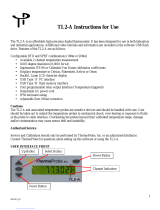
UM10308 All information provided in this document is subject to legal disclaimers. © NXP B.V. 2012. All rights reserved.
User manual Rev. 4.1 — 20 August 2012 6 of 163
NXP Semiconductors
UM10308
P89LPC9331/9341/9351/9361 user manual
P1.0 to P1.7 I/O, I
[1]
Port 1: Port 1 is an 8-bit I/O port with a user-configurable output type, except for
three pins as noted below. During reset Port 1 latches are configured in the input
only mode with the internal pull-up disabled. The operation of the configurable
Port 1 pins as inputs and outputs depends upon the port configuration selected.
Each of the configurable port pins are programmed independently. Refer to
Section 5.1 “
Port configurations” for details. P1.2 to P1.3 are open drain when
used as outputs. P1.5 is input only.
All pins have Schmitt trigger inputs.
Port 1 also provides various special functions as described below:
P1.0/TXD 18 I/O P1.0 — Port 1 bit 0.
O TXD — Transmitter output for serial port.
P1.1/RXD 17 I/O P1.1 — Port 1 bit 1.
I RXD — Receiver input for serial port.
P1.2/T0/SCL 12 I/O P1.2 — Port 1 bit 2 (open-drain when used as output).
I/O T0 — Timer/counter 0 external count input or overflow output (open-drain when
used as output).
I/O SCL — I
2
C-bus serial clock input/output.
P1.3/INT0
/SDA 11 I/O P1.3 — Port 1 bit 3 (open-drain when used as output).
I INT0
— External interrupt 0 input.
I/O SDA — I
2
C-bus serial data input/output.
P1.4/INT1
10 I/O P1.4 — Port 1 bit 4. High current source.
I INT1
— External interrupt 1 input.
P1.5/RST
6IP1.5 — Port 1 bit 5 (input only).
I RST
— External Reset input during power-on or if selected via UCFG1. When
functioning as a reset input, a LOW on this pin resets the microcontroller, causing
I/O ports and peripherals to take on their default states, and the processor begins
execution at address 0. Also used during a power-on sequence to force ISP mode.
P1.6/OCB 5 I/O P1.6 — Port 1 bit 6. High current source.
O OCB — Output Compare B. (P89LPC9351/9361)
P1.7/OCC/AD00 4 I/O P1.7 — Port 1 bit 7. High current source.
O OCC — Output Compare C. (P89LPC9351/9361)
I AD00 — ADC0 channel 0 analog input.
P2.0 to P2.7 I/O Port 2: Port 2 is an 8-bit I/O port with a user-configurable output type. During reset
Port 2 latches are configured in the input only mode with the internal pull-up
disabled. The operation of Port 2 pins as inputs and outputs depends upon the port
configuration selected. Each port pin is configured independently. Refer to Section
5.1 “Port configurations” for details.
All pins have Schmitt trigger inputs.
Port 2 also provides various special functions as described below:
P2.0/ICB/DAC0
/AD03
1I/OP2.0 — Port 2 bit 0.
I ICB — Input Capture B. (P89LPC9351/9361)
O DAC0 — Digital-to-analog converter output.
I AD03 — ADC0 channel 3 analog input.
Table 2. Pin description
…continued
Symbol Pin Type Description
PLCC28,
TSSOP28






















